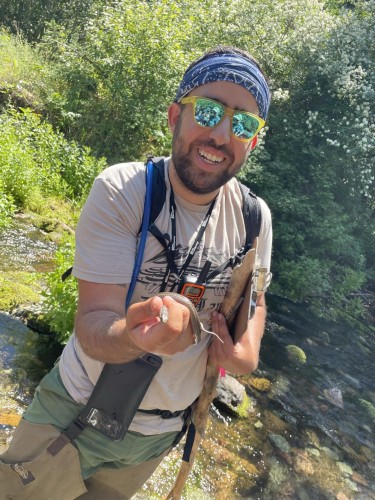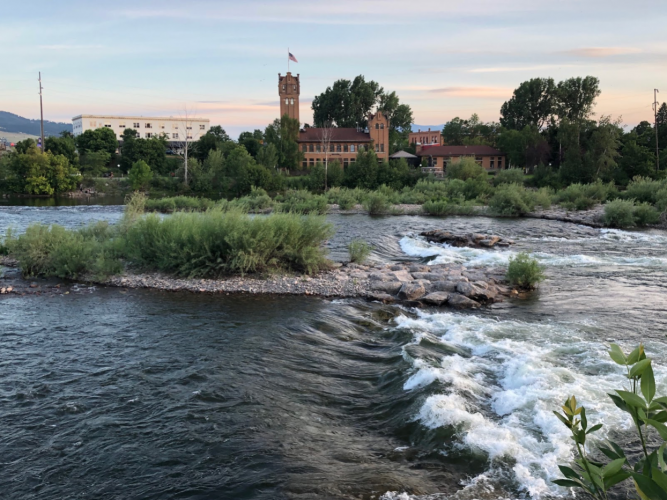Project Duration
2018-present
Location
Missoula County, Montana
Background
Originally built to provide water for the City of Missoula
in 1904, the Rattlesnake Creek Dam was first constructed as
a wooden structure and later converted into a concrete one. After
problems with Giardia contamination in the
early 1980s, a private utility took the dam offline and the City
of Missoula converted to groundwater as its primary source
for drinking water. Since then and after suffering additional
damage, the Rattlesnake Creek Dam has remained obsolete, posing a
public safety risk and blocking the passage of threatened fish
species trying to access important upstream spawning
habitat.
After acquiring the dam in 2017, the City of Missoula entered
into an agreement with Trout
Unlimited to remove the Rattlesnake Creek Dam in 2020 as part
of a broader Clark Fork River restoration effort that will
improve watershed health and public access.
Together with other stakeholder organizations like Watershed Education
Network, Trout Unlimited is working to monitor the impacts of
the dam’s removal at several sites along Rattlesnake Creek,
data from which will be used by both scientists and land managers
to assess and respond to the biological, physical, and chemical
impacts in the watershed.
Meeting with Local Partners
In July 2019, faculty director Heidi Ballard, Executive
Director Ryan Meyer, and graduate student
Chris Jadallah spent time with partners in
Missoula at Trout Unlimited, the Watershed Education Network, and
the Resources Legacy
Fund to discuss community-based monitoring in the
context of the Rattlesnake Creek Dam removal. Through a carefully
delineated combination of citizen science and professional
monitoring, our partners will work to collect and
analyze the monitoring data to inform scientific research
and site management. By engaging Missoula residents in the
monitoring of their local watershed, local partners are also
creating powerful opportunities for place-based environmental
science education and broader community impacts tied to
stewardship, civic action, and social learning.
Conversations with these partners and observations
of citizen science “Stream Teams” in action allowed us to
share information on achieving multiple goals (from generating
high quality data to promoting youth education) through
citizen science while also learning more about
their process of building a collaborative monitoring plan,
which is highlighted in
our manual to support citizen science and dam removal
across the Western United States.
Funders
Resources Legacy Fund
Partners
Watershed Education Network, Trout Unlimited
 Western Montana’s Rattlesnake Creek
and its many relations – human and more-than-human – are at the
heart of our ongoing research-practice partnership between
Watershed Education Network (WEN) and the UC Davis Center for
Community and Citizen Science. As part of this partnership, I was
fortunate enough to visit Missoula this past summer to collect
data that will help us document how WEN’s Stream Team and
Backcountry Stream Corps programs are fostering community impacts
in the Rattlesnake Creek watershed and beyond.
Western Montana’s Rattlesnake Creek
and its many relations – human and more-than-human – are at the
heart of our ongoing research-practice partnership between
Watershed Education Network (WEN) and the UC Davis Center for
Community and Citizen Science. As part of this partnership, I was
fortunate enough to visit Missoula this past summer to collect
data that will help us document how WEN’s Stream Team and
Backcountry Stream Corps programs are fostering community impacts
in the Rattlesnake Creek watershed and beyond.
 With support from the Open
Rivers Fund, a program run by the Resources Legacy Fund, our
Dams and Watershed Health team,
Heidi Ballard, Ryan Meyer, and Chris Jadallah traveled to
Missoula, Montana in July 2019 to observe and participate in
the environmental monitoring associated with the removal of
Rattlesnake Creek Dam. Through meetings and hands-on experience,
we got an up-close look at both the promise and the challenges of
monitoring collaborations focused on dam removal.
With support from the Open
Rivers Fund, a program run by the Resources Legacy Fund, our
Dams and Watershed Health team,
Heidi Ballard, Ryan Meyer, and Chris Jadallah traveled to
Missoula, Montana in July 2019 to observe and participate in
the environmental monitoring associated with the removal of
Rattlesnake Creek Dam. Through meetings and hands-on experience,
we got an up-close look at both the promise and the challenges of
monitoring collaborations focused on dam removal.










